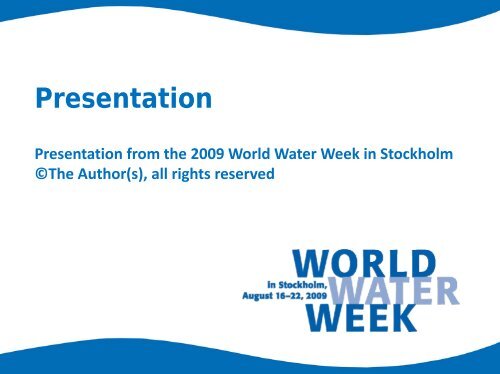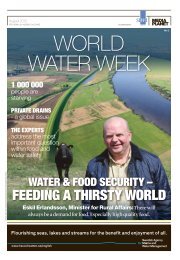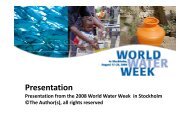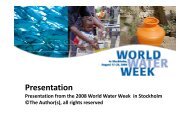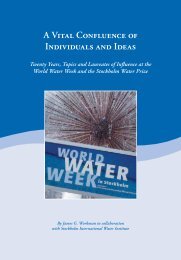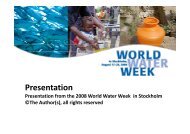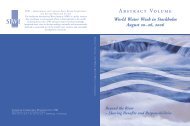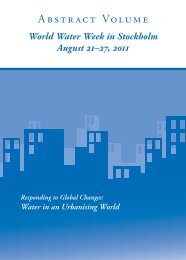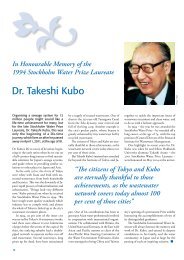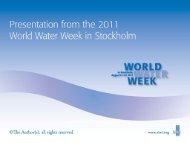Tunisia - World Water Week
Tunisia - World Water Week
Tunisia - World Water Week
- No tags were found...
You also want an ePaper? Increase the reach of your titles
YUMPU automatically turns print PDFs into web optimized ePapers that Google loves.
Wastewater Reuse in The Mediterranean Region:Barriers and OpportunitiesKHALIL ATTIACEO - ONASStockholm, August 17, 2009
Table of contents1WATER RESOURCES MANAGMENT2SANITATION3TREATED WASTEWATER REUSEMellegue Dam
Mejerda-Cap Bon Canal
<strong>Tunisia</strong>SWEEDEN• located on the southern rimof the Mediterranean sea• Population ofapproximately 10 million• Area: 165.000 km 2• Semi-arid climate andfragile natural resources.TUNISIA4
Gulfof TunisGulfof HammametWith around 450 m3 per capita offreshwater availability,<strong>Tunisia</strong> is one of the most droughtstressedcountries in the MENA region.5
WATER RSOURCES MOBILIZATIONIN TUNISIA3000250020001500100050022002700780745M m 3 /year11601400MobilizedResourcesResources0Surface <strong>Water</strong> <strong>Water</strong> Table Deep Aquifers- 29 MAJOR DAMS, 190 HILLSIDE DAMS, 720 HILLSIDE LAKES- 4800 DEEP WELLS- 130 000 SURFACE WELLS- DESALINATION: SOW FAR (4 plants) : 21 Mm3/year;OBJECTIVE BY 2030: 50 Mm37
SIDI SALEM DAM8
WATER DEMAND(million m3)2600210016001100600100-40015752100 2138 21402035240 310 321 380 49185 96 124 136 203 20 23 26 31 411920 2529 2609 2687 27701990 1994 2006 2010 2030Irrigation water drinking water Industry TourismResources / NeedsTotal resourcesNeedsYear11
IMPACTS OF CLIMATE CHANGE<strong>Tunisia</strong> is particularly vulnerable to the effects of climate risks: 10 to 30% reduction of rainfall The sea level rise would produce effects on someof coastal surface aquifers12
Thus,problems of water scarcity will increase because of:‣ Socio-economic development demand and populationgrowth,‣ climate change impactsThen,developing additional water resources has become a must.Therefore,treated wastewater reuse will be an important component ofthe water management strategy.13
Djerba – Houmet Souk, wwtp 14
NATIONAL SANITATION UTILITY « ONAS »Established in 1974 as a public institution with industrial and commercial characterMISSIONIn charge of the sanitation sector management and water pollution controlHuman Resources4700 Employees520 with higher education degrees270 of which are EngineersEquipment fleet250 hydro-cleaners and suction pressureand sludge-removal equipments7 pipe-inspection units (by video-cam).15
OPERATIONAL DATA (2008)Population benefiting from ONAS services/In million inhabitants (population in the urban areas: 6.8 M inhab)Rate of connection in localities managed by ONASNumber of subscribers (x1000)Total length of networks (km)Number of wwtpPumping stationTreated wastewater quantities (Mm3/year)Reuse of treated wastewater (ratio)Number of employees /10 km of sewage network6.188 %1 43814 14710065023029%2.816
INVESTMENTS EVOLUTION IN SANITATIONMillions of Dinars (1 €=1.9 DT)6005306005004003963002001000234125925861974/76 1977/81 1982/1986 1987/1991 1992/1996 1997/2001 2002/2006 2007/2001117
120090060030005Investment14046315381975 1985 1995 2008Total Investment (MDT)1008060402004523Connection5640756388821975 1985 1995 2008Rate of connection in municipalities managed by ONAS (%)Rate of connection in the urban areas (%)10080Treatmentplants10012000Network141476040200482251975 1985 1995 20089000600030000900307065181975 1985 1995 2008Number of wwtpLength of networks (Km)18
100%90%80%70%60%50%40%30%20%10%0%CONNECTION TO DRINKING WATERAND SANITATION99% 99%88% 91%82%1975 1981 1987 1994 2000 2008 201187%Rate of connection to the urban drinking water networkRate of connection in the municipalities managed by ONASRate of connection in the urban areas19
Choutrana20
Ben Arous (industrial wwtp)21
North Sousse22
Hammamet23
Zriba24
Douz25
Tozeur26
TREATED WASTEWATERREUSE
2502002362301501005005 21301126298742431975 1985 1995 200867Collected wastewater (Mm3)Treated wastewater (Mm3)Reuse of treated wastewaterEvolution of irrigated areas12000Evolution des espaces irrigués avec l'eau usée traitée100008000en ha60004000200001965 1982 1987 1989 2000 2006 2008Annéesyear28
LEGISLATION ON THE TWW REUSETreated wastewater reuse in agriculture is regulated by :• the 1975 water law• the 1989 decree (decree n° 89-1047).However,The WATER LAW PROHIBITS THE USE OF RAWWASTEWATER IN AGRICULTURERECLAIMED WATER USE IS FORBIDDEN FORVEGETABLES IRRIGATION29
In separate documents, there are also :Reclaimed water quality standards for reuse(<strong>Tunisia</strong>n Standard 106.03, 1989).Wastewater disposal standards in receivingwaters (<strong>Tunisia</strong>n Standard 106.02, 1989) will bemodified in order to be in conformity with the EUstandardsA list of crops that can be irrigated with TWW.30
MONITORING AND QUALITY CONTROLOF TWWR4 levels of monitoring :The self monitoring by O.N.ASMinistry of Public HealthNational Environmental Protection Agency (ANPE)Ministry of Agriculture and water user’s associations.31
FIELDS OF REUSEFodder Crops69%IndustrielCultures5%Golf Courses10%Fruit Trees15%Aquifierrecharge andEcologicalsystems1%32
Agriculturalirrigation33
Landscape irrigation34
Groundwater recharge35
CONSTRAINTS RELATED TO TWW REUSECurrent reuse rate is only 28 - 30 % due to :The non availability of the agricultural lands close to bigwastewater treatment plants (larger cities).Crop restriction.Competition with the conventional water (in the North).Demand variability over the seasons without storagecapacities.WW quality instability in some cases (industrial effluents)·Limited fields of TWW ReuseTWWR acceptability.37
APPROACH TO DEVELOP THE TWW REUSEIn coordination with the different stakeholders in thisfield, ONAS endeavors to :Achieve better control over treated wastewaterquality.Develop the legal framework for TWW Reuse.Boost agricultural TWW Reuse.Extend and develop the fields of TWW Reuse.38
BETTER CONTROL OF TWW QUALITYONAS is implementing a comprehensive programof rehabilitation and expansion of 25 existingWWT Plants.In such a way to meet the needs of socio-economicdevelopment and to guarantee a good and stabletreatment performances39
ENHANCING THE CURRENT LEGAL TEXTSON TWW REUSE• The amendment of the <strong>Tunisia</strong>n Standards (NT106.02and NT106.03) on wastewater treatment relating tocertain physiochemical, bacteriological and biologicalcriteria.• Develop legal texts related to TWW Reuse in otherpurposes than agricultural.40
BOOSTING AGRICULTURAL TWW REUSEA three components program is implemented : Creation of new irrigated areas (1985 ha). Extension of the existing irrigated areas (1530 ha). Rehabilitation of the existing irrigated areas (5480 ha).But,these 3 measures can not achieve more than 35% reuserate.41
EXTEND AND DEVELOP THE FIELDSOF TWW REUSEAll studies conducted on this issue conclude that :In particular,To achieve higher rates of reuseneedsto transfer TWW to water-short zones More than 40 % of the TWW is produced in the Greater Tunis, amongwhich only 15% are reused Agricultural reuse around Tunis is decliningTo promote the TWW Reuse in agriculture and aquifer rechargeand to protect the Gulf of Tunis; The TWW has to be transferredto the inland zones.42
Mediterranean SeaGREATER TUNIS SANITATIONWwtp CHOUTRANAGulf of TunisWwtp CHERGUIATunisWwtp EL ATTARWwtp SUD MELIANEWwtp EL ALLEF44
Technical map45
POTENTIAL OPTIONSA feasibility study was initiated to evaluate the technical,economic and social aspects of three potential options forTWW effluent reuse in the Greater Tunis :Option 1: Discharge into the Sea through outlet ;Option 2: Transfer to inland agricultural areas ;Option 3: Complementary treatment and groundwaterrecharge46
Gulf of TunisDISCHARGE INTO THESEA THROUGH OUTLETSThis option will occur whentreated wastewater is notreused for agriculture (wetyears).Position ofproposed outlets47
VOLUME OF TWW IN GREATER TUNISAvailable for REUSEEstimated TWW & transferred volume in 2021 :Treatment siteTWWvolume(million m 3)TWW needs of plannedprojects in GreaterTunis(million m 3)Volumeavailable fortransfer(millions m 3 )Choutrana - Charguia 91.9 28.9 63Southern Meliane 25.4 7 18.4El Allef 43.2 19.7 23.5El Attar 40.2 12.7 27.5Total Greater Tunis 200.8 68.3 132.448
Potential Zones Reuse for irrigationPHASE I-GreaterTunisGreater Tunis(2000ha-8 Mm3/year)- Zaghouan(13000ha- 42 Mm3/year)ZaghouanBouche zoneZaghouanSaouaf ZonePHASE II- Kairouan(10600ha- 52 Mm3/year)Kairouan49
Potential Zones Reuse for RechargingAquifersPHASE I• Mornag (10,8Mm3)• Grombalia (16Mm3)Aquifer of MornagPHASE II• El Fahs (0,8 Mm3)• Kairouan Sisseb El Allem (2,8 Mm3)Aquifer of FahsAquiferof GrombaliaConditions to be satisfied :• Overexploited aquifers• Aquifers used for agriculturalor industrial purpose only• In accordance with effluentstandards• Increased willingness andacceptability to using TWWAquifer of Sisseb El Allem50
AMOUNT OF INVESTMENT OF PLANNEDPROJECTTotal Investment(million TD)Total Volume(million m3/year)Areas(hectares)PHASE I(2011 – 2016)200 87.6 15 000PHASE II(2016 – 2021)265 44.8 10 60051
ENVIRONMENTAL :THE PROJECT IS EXPECTEDTO GENERATE POTENTIAL BENEFITS- reducing pollution loads in the Mediterranean Sea- increasing vegetation cover and improving degraded lands- conserving biological diversity- reducing carbon dioxide emissions52
SOCIO-ECONOMIC- increasing agricultural productivity- developing industrial crops- improving water use efficiency- improving the adaptation of farmers toextreme climatic schemes- contributing to rural poverty reduction- contributing to the food security objective
an International Conference was organised in orderto facilitate an exchange of experiences, especiallywith countries having already tested this type ofapproach and achieved an advanced stage(California, Australia..)53
Transfer and Reuse of treated Wastewater ConferenceRecommendationsImprove the physio-chemical quality of tww and ensure controlover secondary treatment and additional treatment according tousesConduct a more in-depth reflection on the Over pipe-basedtransfer and conduct the simulations necessary to mitigate theimpacts thereof on the transfer networks and the various treatedwastewater usesRevise the current treatment and reuse approach with a view tolifting the current crop-growing restrictions and overcoming thepsychological constraints and the common mistrust vis-à-vis thequality of treated wastewater54
Transfer and Reuse of treated Wastewater ConferenceRecommendationsPay extreme attention to land property, institutional, coordination,interface and sanitary control aspectsResearch & Development must be undertaken, as of now, bydedicated bodies with a view to providing insight in due time asto certain aspects of the project that are still in need ofelucidation,Show-case farms illustrating and disseminating the newtechniques must be set up in beneficiary areas.55
CEO , ONASWebsite: www.onas.nat.tnE-mail: pdg@onas.nat.tn


